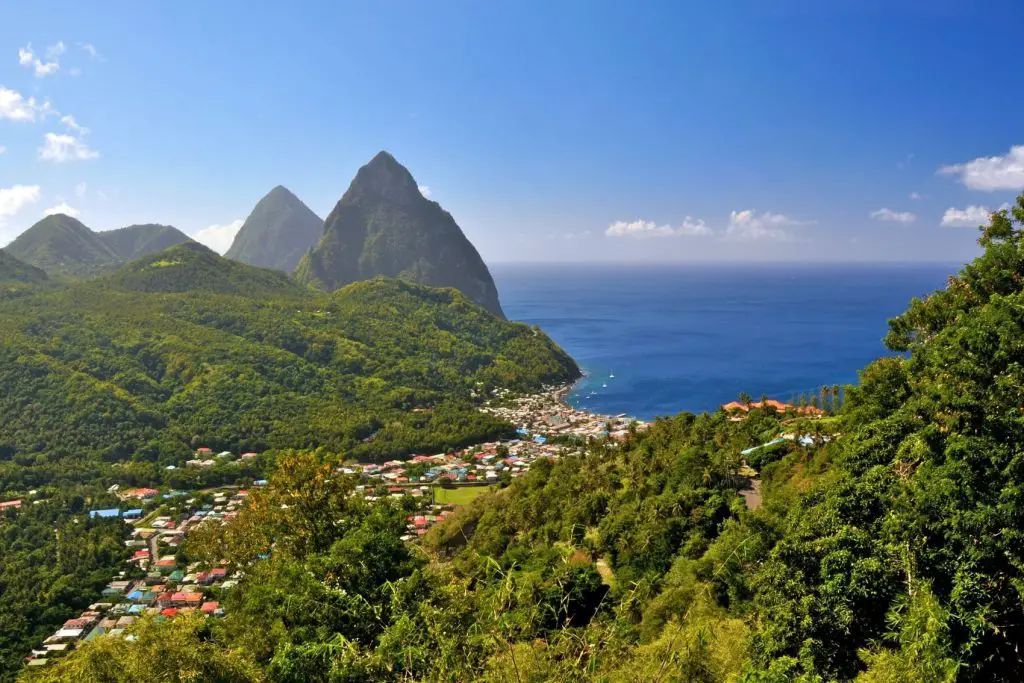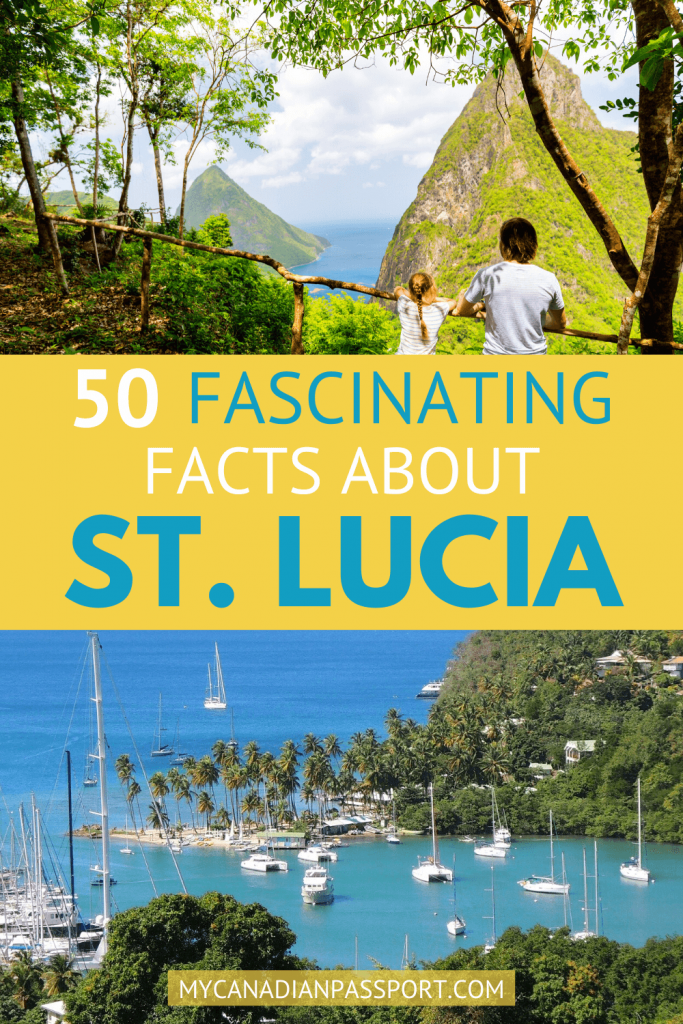To prepare more for my first trip to St. Lucia, I wanted to learn more facts about the beautiful island country I would be visiting. What I ended up learning was incredibly interesting, and since most people don’t know a whole lot about St. Lucia, I thought I’d share the facts here.
If you aren’t already in the process of planning a trip to St. Lucia, you will be after reading this!

Interesting Geographical Facts About St. Lucia
- St. Lucia covers 238.23 square miles and is 27 miles long and 14 miles wide.
- St. Lucia is the second largest of the Windward Islands.
- St. Lucia is located in the Caribbean Sea, as part of the Lesser Antilles. It is bordered by the Northern Atlantic Ocean on one side and the Caribbean Sea on the other. The closest islands to St. Lucia are St. Vincent to the south, and Martinique, to the north.
- With more mountains than most other Caribbean islands, St. Lucia was formed due to volcanic activity.
- The twin volcanic peaks known as the Pitons are both St. Lucia’s most famous landmark and a UNESCO World Heritage Site.
- Standing at 3,117 feet, the summit of Mount Gimie is the highest point on the island.
- St. Lucia is divided into 11 quarters. These are Anse la Raye, Dauphin, Castries, Choiseul, Dennery, Gros Islet, Laborie, Micoud, Praslin, Soufrière and Vieux Fort.
- As of 2020, St. Lucia has an estimated population of 170,000. Roughly 70,000 people live close to the capital city of Castries, while the rest primarily reside around the island’s coastal perimeter.

Interesting Historical Facts About St. Lucia
- St. Lucia was first known as the Island of the Iguanas by the Amerindian Arawak and Carib settlers on the island.
- The island was named after Saint Lucy of Syracuse by a group of French sailors who became shipwrecked and stranded on the island on December 13th, the saint’s feast day.
- St. Lucia is the first and only country in the world to be named after a woman.
- The French were the first European settlers in St Lucia. In 1660, they signed a treaty with the indigenous Carib people.
- Between the years 1663 and 1814, France and England fought over St. Lucia. During that time the island changed hands 14 times which earned it the nickname the “Helen of the West Indies“.
- In 1814, St. Lucia became a crown colony when the French surrendered the island to the British following the Treaty of Paris.
- The British brought in slaves from West Africa to work on the sugar cane plantations.
- In 1834, Slavery was abolished in St. Lucia.
- Between 1871 and 1956, St. Lucia was a member of the Leeward Islands Federation. Then, from 1958 to 1962, it became a member of the Federation of the West Indies.
- Despite the abolishment of slavery, St. Lucia continued to cultivate sugarcane until 1964 when the sugarcane fields were swapped out for banana trees. Today, bananas are the most bountiful crop on the island. Other crops grown in St. Lucia include coconuts, cacao, mango, avocado, cassava and yams.
- St. Lucia gained its independence from England on Feb 22, 1979, becoming an independent state of the Commonwealth of Nations.
- “The Land, The People, The Light” was deemed the national motto of St. Lucia once the island became independent from British rule.

Interesting Cultural Facts About St. Lucia
- As a member of the Commonwealth of Nations, St. Lucia shares Queen Elizabeth II as its head of state, along with Australia, Canada, Jamaica, Barbados, Grenada and 10 other Commonwealth realms. On the island, Queen Elizabeth II is represented by the Governor-General of Saint Lucia, Emmanuel Neville Cenac.
- It is estimated that 85% of St Lucians are direct descendants of African slaves, while the remaining 15% are of British, French, mixed African, or Indian descent.
- Roughly 90% of St. Lucians are Roman Catholic.
- In St. Lucia, most people don’t get married until they enter middle age.
- St. Lucian children are often fostered by relatives, especially grandparents when their parents relocate to find employment opportunities.
- St. Lucian cuisine has many influences from around the world. Some of their traditional dishes include French, British, East Indian and West African flavours.
- In St. Lucian cuisine, common ingredients include potatoes, onions, celery, scotch bonnet peppers, coconut milk, thyme, flour and cornmeal.
- A staple in St. Lucia is the “Johnny Cake,” a type of fried or baked dough that is usually served with sauteed salt fish, peppers and onions.
- Although English is the official language of St. Lucia, more than 95% of the population speak St. Lucian French Creole (Kwéyòl) or Patois (“Patwa”). In fact, it’s estimated that roughly 20% of the population does not speak English at all.
- St. Lucian French Creole is celebrated annually on the last Sunday in October on a day called “Jounen Kwéyòl” or Creole Day.

Interesting Facts About Music & the Arts in St. Lucia
- Musicians from around the globe flock to the annual St. Lucia Jazz Festival is held each May.
- The island’s national anthem is called “Sons and Daughters of Saint Lucia”. It was written by Charles Jesse and set to music by Leton Felix Thomas.
- Many people will recognize St. Lucian actor Joseph Marcell from his role as Geoffrey, the butler in the sitcom “The Fresh Prince of Bel-Air.”
- The works of famous St. Lucian artist Sir Dunstan St. Omer are displayed all over the island in churches and among communities.
Interesting Facts About Tourism in St. Lucia
- Since 1970, tourism has been developing rapidly in St. Lucia.
- The majority of travellers who visit the island are day-trippers who arrive by cruise ship.
- In 2017, St. Lucia had the highest growth rate of all Caribbean Tourism Organization (CTO) members. They hosted more than 1.1 million visitors, 11% more than in the previous year.

Interesting Facts About the Coastal Waters of St. Lucia
- There are four wrecks where you can scuba dive off the coast of St. Lucia. The Lesleen M which is located north of the Pitons is the easiest to dive at a depth of 18 meters/60 feet.
- All of the diveable wrecks around St. Lucia have been sunk intentionally to create artificial reefs.
- As a protected part of the Soufriere Marine Management Area, the waters along the west coast of the island are divided into 5 zones; fishing priority areas, marine reserves, multiple-use areas, recreational areas and yacht mooring areas. Daily fees are charged to those who wish to dive in the reserve.
More Interesting Facts About St. Lucia
- St. Lucia is home to the “world’s only drive-in volcano” at Sulpher Springs Park. Created 410,000 years ago, this active volcano features bubbling springs and warm sulfuric pools where visitors come to take a dip.
- In St. Lucia, the currency used is the East Caribbean Dollar (XCD). However, US dollars are accepted in most tourist destinations on the island. Unlike other currencies, the East Caribbean Dollar to US Dollar has a fixed exchange rate of $1(USD) = $2.70(EC).
- With two Nobel prize winners, St. Lucia has the second-highest ratio of Nobel laureates per capita.
- In 1979, Sir Arthur Lewis received the Nobel Prize in Economics, becoming the first black man to win in a category apart from peace. Poet and playwright Derek Walcott won the Nobel Prize for Literature in 1992.
- The national bird of St. Lucia is the Jacquot, or the St. Lucia Parrot. Its scientific name is Amazona Versicolor and it is endemic only to St. Lucia.
- In St. Lucia, cars drive on the left-hand side of the road (similar to in the UK).
- The runway at George F.L. Charles Airport in Castries is so close to the water that it must be closed when cruise ships are sailing past.
- The island’s local pilsner lager is named “Piton” after the Gros and Petit Piton mountains. Owned by Heineken, Piton beer is brewed exclusively in St. Lucia.
- St. Lucia Distillers, formerly called Roseau Valley is famous for its 21 different varieties of rum.
- The major newspapers in St. Lucia include The Voice, The Times, The Mirror, The Star, The Crusader and One Caribbean.
- The town Soufrière is named after the French word for sulphur because of odour from the boiling Sulphur Springs nearby.
Now that you know all these interesting facts about St. Lucia I’m sure you’ll be eager to start planning your trip. To get you started, check out this helpful guide for first-time visitors to St. Lucia.
PIN IT FOR LATER


